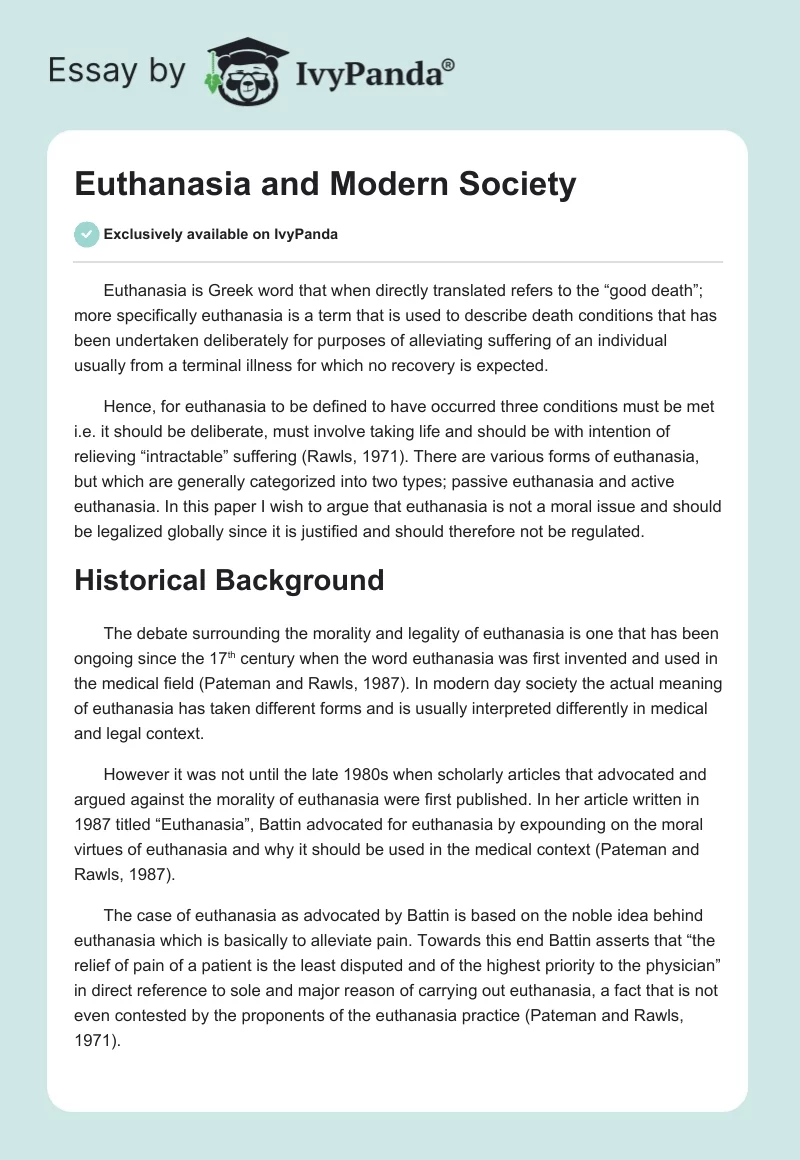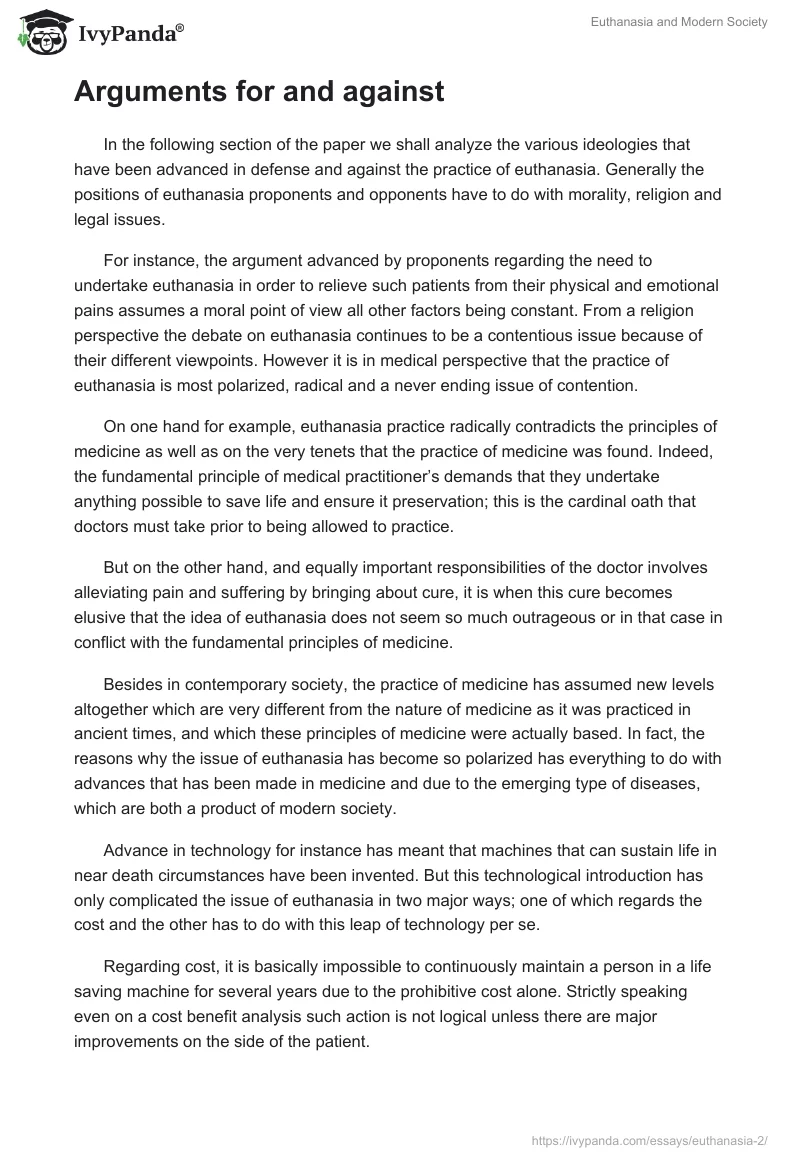Euthanasia is Greek word that when directly translated refers to the “good death”; more specifically euthanasia is a term that is used to describe death conditions that has been undertaken deliberately for purposes of alleviating suffering of an individual usually from a terminal illness for which no recovery is expected.
Hence, for euthanasia to be defined to have occurred three conditions must be met i.e. it should be deliberate, must involve taking life and should be with intention of relieving “intractable” suffering (Rawls, 1971). There are various forms of euthanasia, but which are generally categorized into two types; passive euthanasia and active euthanasia. In this paper I wish to argue that euthanasia is not a moral issue and should be legalized globally since it is justified and should therefore not be regulated.
Historical Background
The debate surrounding the morality and legality of euthanasia is one that has been ongoing since the 17th century when the word euthanasia was first invented and used in the medical field (Pateman and Rawls, 1987). In modern day society the actual meaning of euthanasia has taken different forms and is usually interpreted differently in medical and legal context.
However it was not until the late 1980s when scholarly articles that advocated and argued against the morality of euthanasia were first published. In her article written in 1987 titled “Euthanasia”, Battin advocated for euthanasia by expounding on the moral virtues of euthanasia and why it should be used in the medical context (Pateman and Rawls, 1987).
The case of euthanasia as advocated by Battin is based on the noble idea behind euthanasia which is basically to alleviate pain. Towards this end Battin asserts that “the relief of pain of a patient is the least disputed and of the highest priority to the physician” in direct reference to sole and major reason of carrying out euthanasia, a fact that is not even contested by the proponents of the euthanasia practice (Pateman and Rawls, 1971).
Arguments for and against
In the following section of the paper we shall analyze the various ideologies that have been advanced in defense and against the practice of euthanasia. Generally the positions of euthanasia proponents and opponents have to do with morality, religion and legal issues.
For instance, the argument advanced by proponents regarding the need to undertake euthanasia in order to relieve such patients from their physical and emotional pains assumes a moral point of view all other factors being constant. From a religion perspective the debate on euthanasia continues to be a contentious issue because of their different viewpoints. However it is in medical perspective that the practice of euthanasia is most polarized, radical and a never ending issue of contention.
On one hand for example, euthanasia practice radically contradicts the principles of medicine as well as on the very tenets that the practice of medicine was found. Indeed, the fundamental principle of medical practitioner’s demands that they undertake anything possible to save life and ensure it preservation; this is the cardinal oath that doctors must take prior to being allowed to practice.
But on the other hand, and equally important responsibilities of the doctor involves alleviating pain and suffering by bringing about cure, it is when this cure becomes elusive that the idea of euthanasia does not seem so much outrageous or in that case in conflict with the fundamental principles of medicine.
Besides in contemporary society, the practice of medicine has assumed new levels altogether which are very different from the nature of medicine as it was practiced in ancient times, and which these principles of medicine were actually based. In fact, the reasons why the issue of euthanasia has become so polarized has everything to do with advances that has been made in medicine and due to the emerging type of diseases, which are both a product of modern society.
Advance in technology for instance has meant that machines that can sustain life in near death circumstances have been invented. But this technological introduction has only complicated the issue of euthanasia in two major ways; one of which regards the cost and the other has to do with this leap of technology per se.
Regarding cost, it is basically impossible to continuously maintain a person in a life saving machine for several years due to the prohibitive cost alone. Strictly speaking even on a cost benefit analysis such action is not logical unless there are major improvements on the side of the patient.
Another reason why lives saving machines have complicated the issue of euthanasia is because this technological leap has necessitated the redefinition of death, death in the sense of when it should be presumed to occur and for very good reasons.
Indeed, the fact that this life supporting machines have the capability to continue sustaining life in patients that are in vegetative state requires us to redefine when death should be presumed to occur especially given their ability to sustain life even when massive organ failure occurs, usually what would have resulted to death were it not for the ability of this machines.
Due to this eventuality brought about by this technological advent, modern day definition of death has also taken several meanings. The definition of death as it is currently described includes three forms; whole brain death, higher brain death and traditional death which is usually through cardiovascular arrest (Hassan, 2006).
These various definitions of death are for the purpose of providing leeway of undertaking or preventing euthanasia based on the perspective that one get to look at it. For instance when death is defined as having occurred due to higher brain death, then life support machine is not necessary and can be removed since death in this case is not subject to cardiovascular arrest but rather to higher brain activity (Hassan, 2006); I say this is just being hypocritical.
However in traditional terms life support machines cannot be withdrawn from patients since their death is subject to their cardiovascular arrest which is incidentally enabled through the life supporting machines (Hassan, 2006); (this is even more ironical).
Finally the reason why modernity complicates the issue of euthanasia is because of the increase and emerging of new diseases that are increasingly becoming not only terminal but very painful and humiliating as well. Most of these diseases are a product of modernity and are usually the one at the centre of euthanasia debate mainly because they are terminal and painful diseases.
However, the debate on euthanasia is hardly limited to the various perspectives of legal, medical, moral and religion as we have so far discussed, but also involve philosophical perspectives as well.
The Social Contract Theory is an ideology that is largely attributed to Thomas Hobbes although its concepts have been around for quite some time (Celeste, 2004). In Social Theory Contract, Hobbes argues that human are rational beings but which only reason and act with their best interests at heart in what he refers as “coomodious living” which entail various aspects of life such as morality, society and politics (Celeste, 2004).
The relevance of this theory therefore in the context of euthanasia is that people’s moral standings are usually tied together with the political factors of the society. Perhaps, what Hobbes is advocating concerning euthanasia, is to let the moral and political factors of a society be the framework of determining the justification of euthanasia.
An even more unusual theory regarding euthanasia has been advanced by Susan Wolf in a critique of the Physician Assisted Suicide (PAS) concept in which the influence of culture, socialization and sexism as determinant factors of euthanasia are adequately tackled (Dieterle, 2007). The underlying argument that Wolf attempts to portray in that paper claims that euthanasia is largely a gender issue which should not be legalized under the existing legal laws and cultural practices of the society.
In this paper, the practice of euthanasia is described to be gender based in that women are affected differently by the practice compared to men and are more predisposed to the practice than men, mainly because the culture in America tends to devalue women who are terminally ill, disabled or considerably aged more than is the case for their male counterparts (Dieterle, 2007).
In this critique by wolf two major points are raised to support her claim of gender based euthanasia, one of which she claims that majority of persons that are likely to seek PAS would be females rather than males, which in itself is an injustice.
However, data analysis of the various countries and states in America that have so far legalized euthanasia turns out not to support this assertion. The trend is the same even for other countries that have allowed euthanasia such as Netherlands where males constitutes the larger percentage than females.
Conclusion
As we can see from the facts discussed it is clear that the modern society has evolved to a point that justifies euthanasia because of the strides in technology and lifestyle changes that necessitates that people be mercifully relieved of life should the situation demand so.
As it is, governments have circumvented the legalization of euthanasia by giving it different definitions as we have seen to fit its intentions. But at the end of the day it is euthanasia, and it is not right to discriminate against citizens based on the nature of death and in the process deny those who also need it as much.
References
Celeste, F. (2004). Social Contract Theory: Internet Encyclopedia of Philosophy. Web.
Dieterle, J. (2007). Physician Assisted Suicide: A New Look at the Arguments. Bioethics, 21 (3): 127-139.
Hassan, O. (2006). Euthanasia: Ethic-Legal Issues. Web.
Pateman, C & Rawls, J. (1987). Euthanasia in Health Care Ethics: An Introduction. Carlifornia, CA: Temple University Press.
Rawls, J. (1971). A Theory of Justice. Washington, DC: Harvard University Press.


